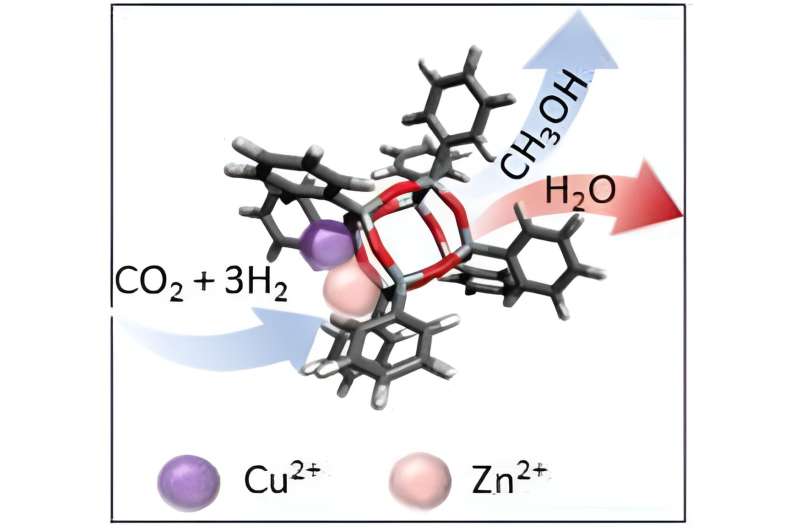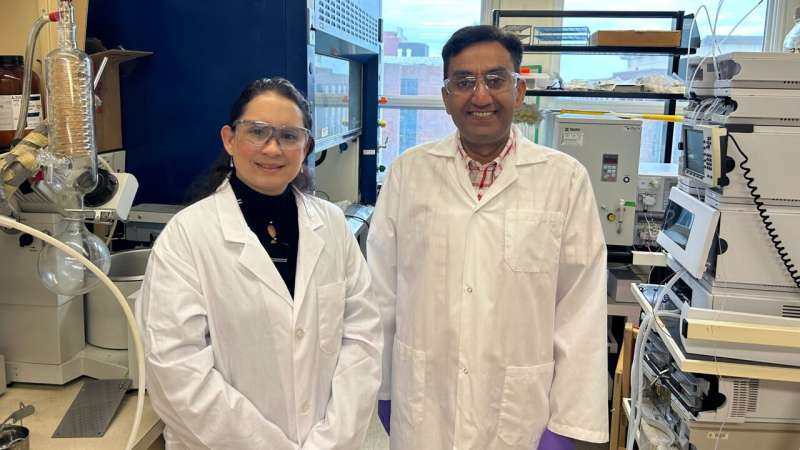This article has been reviewed according to Science X's editorial process and policies. Editors have highlighted the following attributes while ensuring the content's credibility:
fact-checked
peer-reviewed publication
trusted source
proofread
Researcher develops better ways to convert CO2 and biofuel byproducts into valuable chemicals

A University of Alberta researcher has developed better ways to convert carbon dioxide, a harmful greenhouse gas, and glycerol, a leftover of biodiesel production, into value-added materials with wide-ranging uses including liquid hydrogen storage.
The pair of procedures, which will be tested on a larger scale for industry-level viability, represent an important step forward in sustainability, says Yanet Rodriguez Herrero, who conducted the work to earn a Ph.D. in bioresource technology and food engineering from the Faculty of Agricultural, Life & Environmental Sciences.
"We've broken a barrier in terms of improving difficult conversion processes and making them more efficient."
Though CO2 is a major contributor to climate change, it also has potential to be converted into methanol, a highly valuable chemical that can be used in several industrial applications including automotive, electronic, clothing, adhesives, paints and coatings, packaging, solvents, pharmaceuticals and agricultural chemicals.
Methanol also holds promise as a method of transporting and storing hydrogen in liquid form.
But one of the major barriers to successfully converting CO2 into methanol is the water formed as a byproduct during the hydrogenation process, which deactivates a catalyst needed for the transformation.
Using nanotechnology, Herrero successfully developed a process in the lab to prepare a stable catalyst that has the ability to repel water so it works well at low pressure and temperature, making the conversion less energy-intensive and more economically efficient. The research is published in ACS Applied Materials & Interfaces.
Once the process can be successfully scaled up for use by industry, it could mean direct utilization of large amounts of CO2 that has been captured and stored, along with its potential for liquid hydrogen storage, says Aman Ullah, a professor in the Faculty of Agricultural, Life & Environmental Sciences who supervised Herrero's work.

"The conversion of CO2 into various value-added products would be a more logical idea to reduce emissions, with huge benefits for the chemical industry."
The new process also "opens the door" for improving other catalytic chemical conversion processes that are deactivated by water, such as ammonia synthesis, Herrero notes.
"It is difficult to find catalytic supports that are thermally stable and water repellent. In achieving that, our process could be very useful to manufacturing other products such as ammonia and catalytic converters," she says, adding that a patent application is underway for the new process.
Similarly, glycerol—a thick, colorless and odorless liquid—holds potential to be used in the food, pharmaceutical and cosmetics industries, but not in its crude form. Glycerol is the main byproduct left behind from manufacturing biodiesel and compounds called oleochemicals derived from vegetable and animal oil and fat. But it is expensive to purify, making it too costly for large-scale industrial use.
To help overcome that challenge, Herrero developed a patented process to convert the crude glycerol into monomers. The chemicals are important in creating polymers—synthetic substances with a wide range of uses, such as making biopolymers for the consolidation of fluid fine tailings (FFT). Slow consolidation of FFT has been identified as the major challenge for the oilsands industry toward sustainable reclamation.
The biopolymers created through Herrero's process proved more effective in consolidating tailings and improving water recovery compared to PAM, a polymer currently being tested by the resource industry, the research showed.
The conversion process can also help the biodiesel industry address an emerging question, as production ramps up, of how to make use of the glycerol, Ullah notes.
"The industry is facing the dilemma, on the one hand, of how to meet a growing demand for biofuels, while also managing excessive crude glycerol so it doesn't pose a threat to the environment."
During the course of their research, Herrero and Ullah also investigated sustainability as an additional aspect of the conversion process.
By comparing the use of a microwave heating process with conventional heating sources such as hotplates, they showed that using microwave technology was more than 16 times less energy-intensive than conventional heating sources. The process is currently being used by an Edmonton-based biorefining company to produce chemicals more efficiently using lipids and waste glycerol.
Collectively, all of the research results show promising benefits to the energy, hydrogen, biofuel, food and chemical industries, Ullah says.
"By potentially offering sustainable alternatives for creating value-added products, our processes provide a win-win situation economically and environmentally."
More information: Yanet Rodriguez Herrero et al, Hydrophobic Polyhedral Oligomeric Silsesquioxane Support Enhanced Methanol Production from CO2 Hydrogenation, ACS Applied Materials & Interfaces (2023). DOI: 10.1021/acsami.3c00183
Journal information: ACS Applied Materials and Interfaces
Provided by University of Alberta





















